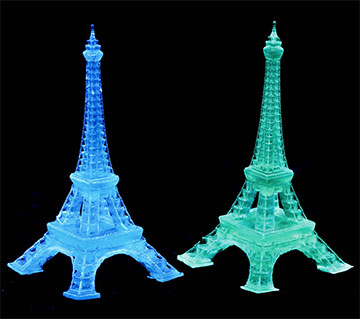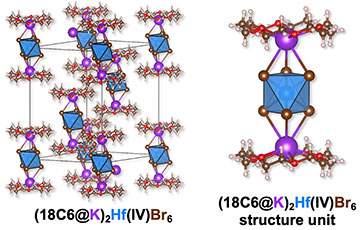Eiffel Tower–shaped luminescent structures 3D-printed from supramolecular ink. Each 2cm-tall device is fabricated from supramolecular ink that emits blue or green light when exposed to 254 nm ultraviolet light. [Image: Peidong Yang and Cheng Zhu / Berkeley Lab, courtesy of the journal Science]
Researchers in the United States have developed a new 3D-printable crystalline material suitable for fabricating highly photoluminescent display components (Science, doi:10.1126/science.adi4196). They believe the technology, dubbed “supramolecular ink,” could one day power organic LED (OLED) displays and wearable devices.
Cheaper, brighter metals
During the material’s assembly process, a solution of crown ether—a ring-shaped organic molecule with a strong affinity for cations—guides metal-halide ionic octahedron units of halide perovskites into novel crystal structures. The supramolecular ink consists of powders containing the transition metals hafnium and zirconium, which are more abundant in Earth’s crust and therefore less expensive than rare metals such as iridium, used in some OLEDs.
The process of assembling the supramolecular ink also makes the tiny optoelectronic structures shine brightly in the blue and green regions of the spectrum. Hafnium makes the perovskites emit blue light with a photoluminescence quantum yield (PLQY) of 96.2%, while the zirconium-containing green emitters have a PLQY of 82.7%.
Inside OLEDs
Although OLEDs primarily consist of organic substances, most of them also have a metal component, says Cheng Zhu, a doctoral candidate at the University of California, Berkeley and a member of scientist Peidong Yang’s research group at Lawrence Berkeley National Laboratory. For example, those that contain iridium belong to a group called organometallic chelates.
Some scientists have tried to incorporate aluminum into OLEDs because of its abundance and low cost, but the resulting substances cannot give off blue light and cannot be tuned, Zhu says. As far as the researchers can tell, this is the first time that hafnium has been used as a metal center for OLED structures.
Single-crystal X-ray diffraction image of blue-emitting supramolecular ink (18C6@K)2HfBr6) reveals the atomic structure of a 1 to 2 nm unit cell. These tiny molecular “building block” structures within the ink self-assemble in solution, enabling the material to achieve stable and high-purity synthesis at low temperatures. [Image: Peidong Yang and Cheng Zhu / Berkeley Lab, courtesy of the journal Science]
Once the perovskites were properly assembled, the researchers incorporated them into 3D-printing ink. To avoid interference with the blue and green emitters, the ink contained a photoabsorber-free resin made mainly from photomonomer poly (ethylene glycol) diacrylate but with a high content of photoinhibitor to control the printing resolution. The perovskite powder particles were sufficiently small that they did not affect the quality of the printed structures.
According to Zhu, the team was excited that the blue emitters had near-unity PLQY, a characteristic that he explained demonstrates their exceptional ability to convert nearly all absorbed light into visible light during the emission process. “Blue emitters with near-unity PLQY are very rare and challenging to achieve. We immediately realized that we discovered something special.”
The right recipe
To demonstrate the material’s color tunability and luminescence as an OLED emitter, the researchers fabricated a thin-film display prototype from the composite ink and found that the material is suitable for programmable electronic displays.
According to Zhu, finding the right recipe to synthesize the emitters was the greatest challenge because they had to perfect the solvent concentration, temperature and precursor molecules. (The process of assembling the new material can take place at room temperature up to about 80°C.)
Next, the team wants to explore the potential of using the supramolecular ink for creating lights powered by electricity, Zhu says. Integrating the ink into commercial products will require refinement of large-scale production processes for the material.


